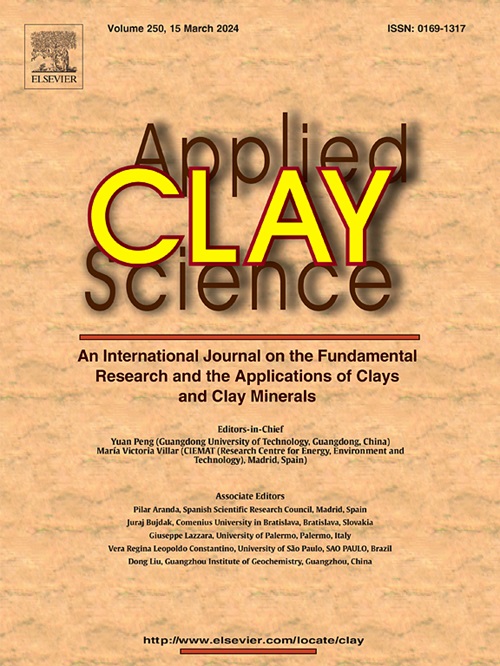直墨书写用地聚合物油墨的流变特性及印刷性能优化
IF 5.3
2区 地球科学
Q2 CHEMISTRY, PHYSICAL
引用次数: 0
摘要
本研究的重点是开发一种专为直接墨水书写(DIW)技术量身定制的偏高岭土聚合物墨水,强调优化流变性能,以实现挤压和形状保持。评估了黄原胶、Triton X 100和peg400三种流变改性剂,以确定有效印刷所需的参数。此外,H₂O₂作为发泡剂加入,以提高材料的孔隙率。在这个过程中,一个重大的挑战是管理正在进行的缩聚反应,这不断改变油墨的流变行为。以偏高岭土和碱性活化剂配制地聚合物浆料,活化剂与偏高岭土的最佳比例为1.25。黄原胶被认为是最有效的添加剂,它创造了一个粘弹性网络,实现了所需的剪切减薄行为,在挤出过程中粘度降低,挤出后迅速恢复。这种行为确保了精确的打印性,同时保持了形状的完整性。确定了最佳打印性能的关键参数:喷嘴直径0.84 mm,打印速度5 mm/s,层高0.6 mm。在长达90分钟的保持时间内保持打印质量需要微调油墨分配速率。这些发现强调了流变特性在解决挑战和设计用于DIW应用的高性能地聚合物油墨方面的重要性。本文章由计算机程序翻译,如有差异,请以英文原文为准。

Rheological behaviour and printability optimization of geopolymer ink for direct ink writing
This study focuses on developing a metakaolin-based geopolymer ink tailored for the Direct Ink Writing (DIW) technique, emphasizing optimizing rheological properties to achieve extrusion and shape retention. Three rheological modifiers, Xanthan gum, Triton X 100, and PEG 400, were evaluated to determine the parameters necessary for effective printing. Additionally, H₂O₂ was incorporated as a foaming agent to enhance the material's porosity. A significant challenge in this process was managing the ongoing polycondensation reactions, which continuously altered the ink's rheological behaviour. The geopolymer slurry was formulated using metakaolin and an alkaline activator with an optimized activator-to-metakaolin ratio of 1.25. Xanthan gum was identified as the most effective additive, creating a viscoelastic network that enabled the required shear-thinning behaviour, where the viscosity decreases during extrusion and rapidly recovers post-extrusion. This behaviour ensured precise printability while maintaining shape integrity. Key parameters were established for optimal printing performance: a nozzle diameter of 0.84 mm, a printing speed of 5 mm/s, and a layer height of 0.6 mm. Maintaining print quality during a holding time of up to 90 min required fine-tuning the ink dispensing rate. These findings underscore the importance of rheological characterization in addressing the challenges and enabling the design of high-performance Geopolymer ink for DIW applications.
求助全文
通过发布文献求助,成功后即可免费获取论文全文。
去求助
来源期刊

Applied Clay Science
地学-矿物学
CiteScore
10.30
自引率
10.70%
发文量
289
审稿时长
39 days
期刊介绍:
Applied Clay Science aims to be an international journal attracting high quality scientific papers on clays and clay minerals, including research papers, reviews, and technical notes. The journal covers typical subjects of Fundamental and Applied Clay Science such as:
• Synthesis and purification
• Structural, crystallographic and mineralogical properties of clays and clay minerals
• Thermal properties of clays and clay minerals
• Physico-chemical properties including i) surface and interface properties; ii) thermodynamic properties; iii) mechanical properties
• Interaction with water, with polar and apolar molecules
• Colloidal properties and rheology
• Adsorption, Intercalation, Ionic exchange
• Genesis and deposits of clay minerals
• Geology and geochemistry of clays
• Modification of clays and clay minerals properties by thermal and physical treatments
• Modification by chemical treatments with organic and inorganic molecules(organoclays, pillared clays)
• Modification by biological microorganisms. etc...
 求助内容:
求助内容: 应助结果提醒方式:
应助结果提醒方式:


